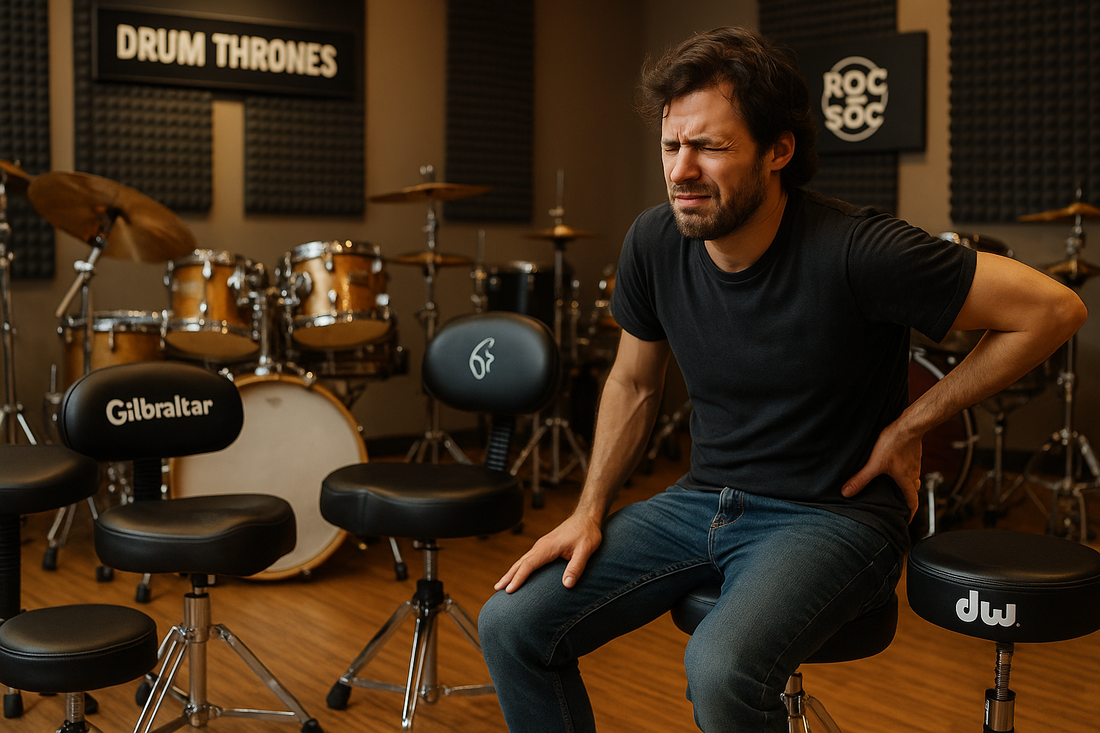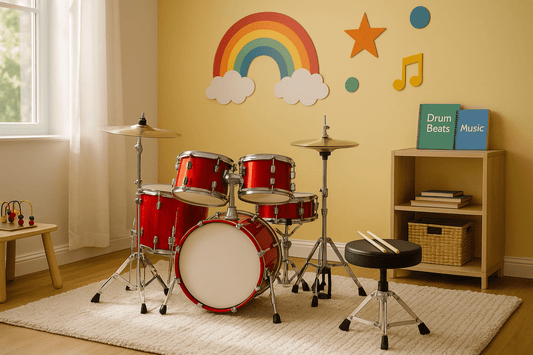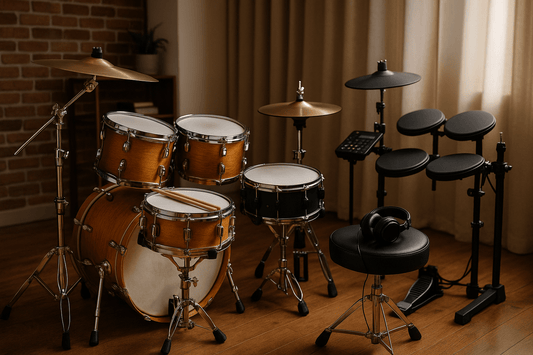Introduction
Why the Right Drum Throne Matters More Than You Think
When most drummers think about upgrading their gear, the spotlight usually goes to flashy cymbals, slick new snares, or a killer kick pedal. But what’s often overlooked? The drum throne—the one piece of equipment you use for every single note you play. The truth is, your seat has a direct impact on your performance, stamina, and even your health.
A bad throne choice can quietly sabotage your playing over time. From poor posture and back pain to sloppy technique and decreased control, the wrong stool slowly chips away at your precision. But here’s the kicker: many drummers don’t even realize their throne is the problem—until it’s too late.
In this article, we’ll explore five of the most common mistakes drummers make when buying a throne and show you exactly how to avoid them. We’ll use real-world scenarios, expert advice, and practical tips to help you make an informed choice that supports your craft, your comfort, and your career.
Real Problems Real Drummers Face
Ask any seasoned drummer and they’ll likely tell you a story about their "first" throne—usually a wobbly, thin-cushioned, unstable mess that left their lower back screaming after just an hour. These are not rare cases. They’re reality for many players who underestimate how central the throne is to their kit.
Some common complaints we’ve heard:
-
“My legs go numb halfway through a set.”
-
“I can’t sit straight without slouching.”
-
“The seat keeps shifting during fast playing.”
-
“My tailbone is sore after every practice.”
These aren’t signs of bad playing—they’re symptoms of bad gear. Let’s get into the first major mistake.
Mistake #1: Choosing Style Over Ergonomics
The Illusion of Cool Looks
We get it—gear that looks cool can be a huge draw, especially when you’re setting up for your first gig or filming content for social media. A throne with slick graphics or an edgy design might catch your eye. But here’s the hard truth: looks fade, and back pain lasts.
Choosing a throne based on visuals alone is a rookie move. It’s easy to fall for flashy designs or branded seats without considering how they’ll affect your posture, weight distribution, or blood flow.
Some trendy models come with thin cushioning or awkward shapes that look great but feel terrible after 30 minutes. You might not notice it at first, but after a few practices or a gig, your body will be screaming at you.
How It Impacts Your Posture and Endurance
Drummers are athletes. You’re using all four limbs, balancing dynamic movement with precision control. A throne that lacks ergonomic design forces your spine into unnatural angles, flattens your pelvic tilt, and causes core fatigue way too soon.
The result? Slouched shoulders, tight hips, lower back strain, and eventually, bad habits that bleed into your playing technique. You’ll be using more effort to stay balanced, leaving you drained before the show’s even over.
Solution: Prioritize Ergonomic Design and Fit
Instead of judging thrones by their looks, focus on the shape and material of the seat. Look for motorcycle-style or saddle-shaped seats that support your thighs and promote natural spinal alignment. Opt for high-density foam or gel that won’t flatten over time.
A great example is the Tempo Gear T32, which offers a wide, contoured seat and solid support at a budget-friendly price. Or the Ahead Spinal-G, built with split-seat ergonomics that relieve pressure on the tailbone and reduce fatigue.
In short: your throne should work for your body—not against it. Form follows function, and the cooler choice is always the one that lets you play better, longer, and pain-free.
Mistake #2: Ignoring Adjustability Features
Fixed Height = Fixed Problems
Many entry-level drum thrones come with fixed or very limited height adjustments. While this might seem fine initially, it quickly becomes a problem when you try to fine-tune your posture or adjust to different kit setups.
A throne that’s too high can cause your knees to drop below your hips, putting strain on your lower back. Too low, and you end up hunching over, killing your posture and reducing the power in your strokes—especially with your feet.
A fixed-height throne also doesn’t grow with you. As your style evolves—whether you’re incorporating double bass pedals, changing snare height, or repositioning your toms—you’ll need a throne that adapts to those changes. Without adjustability, you’re stuck compromising on your setup.
How Custom Fit Boosts Comfort and Technique
Being able to tweak your throne height down to the centimeter helps you:
-
Find your ergonomic sweet spot for maximum balance
-
Optimize foot angles for better control over pedals
-
Align your arms and shoulders with your snare and toms for effortless movement
Drummers who sit at the right height tend to play more fluidly and for longer periods, with less strain. You’ll also notice an improvement in your speed and coordination, simply because your body mechanics are working with you, not against you.
Solution: Look for Hydraulic or Spindle-Adjustable Thrones
Skip the one-height-fits-all approach. Choose a throne that features:
-
Hydraulic lifts for quick and smooth height changes (great for live gigs)
-
Spindle adjustments with memory locks (ideal for precision and consistency)
Thrones like the DW 9000 Airlift combine both hydraulic and spindle adjustability, while the Tempo Gear T32 offers a smooth hydraulic mechanism with an accessible price tag.
Remember, adjustability isn’t a luxury—it’s a non-negotiable feature for any serious player.
Mistake #3: Skipping the Test Sit
Why “Looks Good” Isn’t “Feels Good”
It’s easy to get excited about a throne when you're browsing online. The product photos look sleek, the reviews seem solid, and the price is right. But here’s the deal: you won’t truly know how a throne feels until your butt hits the seat.
Every drummer’s body is different—height, weight distribution, hip alignment, and even playing style. What’s comfortable for one player can be torture for another. Skipping a physical test is like buying shoes without trying them on—you might luck out, but chances are, you’ll regret it.
What to Look for in a Test Sit
If you get the chance to sit on a throne in-store, do more than just “take a seat.” Here’s how to test it like a pro:
-
Sit for at least 5 minutes, mimicking your playing posture.
-
Move your feet as if using pedals—does the throne stay stable?
-
Lean slightly—does the seat wobble or shift?
-
Check height changes—is the adjustment smooth and secure?
If it feels even slightly uncomfortable in-store, imagine what it’ll feel like after a two-hour rehearsal.
Solution: Try Before You Buy or Read Trusted Reviews
If in-person testing isn’t possible (especially with online orders), look for detailed video reviews and verified buyer testimonials. Focus on reviews that include:
-
Body type and height of the reviewer
-
Type of music they play
-
Length of usage (day one vs. after months)
Brands like Tempo Gear, Roc-N-Soc, and Gibraltar often have demo models in music stores—so don’t hesitate to ask for a try-out.
Mistake #4: Underestimating Long-Term Comfort
Short-Term Thrill vs. Long-Term Chill
You sit on your throne longer than you hit your snare. It may feel fine for 15 minutes during setup, but if you start shifting, fidgeting, or feeling sore an hour into your session, that initial comfort was a mirage.
This is where many drummers go wrong—they choose a seat based on first impression comfort, not long-session resilience. Thin cushions, stiff seats, or poorly shaped padding all lead to muscle fatigue, numbness, and even nerve compression over time.
The Cost of Fatigue, Numbness, and Injury
A poorly designed seat can:
-
Compress your sciatic nerve
-
Cut off circulation to your legs
-
Cause mid-back and lumbar pain
-
Lead to long-term postural issues or repetitive strain injuries
Once these issues set in, they don’t just affect your playing—they impact your day-to-day life. And no amount of warm-ups or stretches can fix a throne that’s simply not built to support you.
Solution: Invest in Quality Foam and Supportive Shape
When choosing a throne, don’t just check the firmness—look at the foam density and shape retention. Memory foam and gel-infused cushions are ideal for absorbing pressure and bouncing back after hours of use.
Also, consider seat shapes:
-
Round seats give mobility but may lack thigh support.
-
Motorcycle or tractor-style seats support the hips and reduce thigh pressure.
-
Split-seats like the Ahead Spinal-G relieve pressure from the tailbone.
Prioritize comfort for the long haul, not just for the first sit. It’s an investment that protects your body—and your career.
Mistake #5: Compromising on Stability and Build
Wobble Equals Trouble
Nothing kills a groove faster than a shifting seat. A wobbly throne doesn’t just feel wrong—it actively messes with your balance, coordination, and precision. And when your foundation is unstable, everything else in your playing suffers.
Drummers often overlook the throne’s base hardware. Legs that aren’t braced, cheap joints, or loose fittings are a disaster waiting to happen—especially during high-energy gigs or studio recordings.
Poor Construction = Early Replacement
Cheap thrones wear out fast. Thin metal, plastic fittings, or low-grade foam might save you money now, but you’ll be shopping again in a few months. Worse, a failing throne mid-performance isn’t just embarrassing—it’s dangerous.
Common signs of poor construction:
-
Legs bending under weight
-
Seat spinning unintentionally
-
Height adjustment slipping during use
-
Cushion detaching or compressing unevenly
Solution: Choose Double-Braced Legs, Heavy-Duty Build
Look for thrones with:
-
Double-braced tripod legs for maximum support
-
Slip-resistant rubber feet for grip on all surfaces
-
Heavy-duty steel hardware for longevity
Thrones like the DW Airlift and Gibraltar 9608MB are known for their rock-solid construction. Even the Tempo Gear T32, at its price point, uses reinforced legs and strong seat locks that rival higher-end models.
Never compromise on structure. A throne that can’t hold up will hold you back.
Bonus Mistake: Overpaying Without Research
High Price Doesn’t Always Mean High Performance
It’s easy to assume that a higher price tag guarantees better quality. While that might be true in some cases, it’s not a rule. Many drummers have fallen into the trap of buying a $600 throne only to find it lacks essential features, doesn’t fit their body type, or wears down faster than expected.
Some high-end thrones are designed with niche features that might not benefit every drummer. For example, a throne with dual-tilt or memory foam tech may be overkill for a drummer who plays only on weekends. On the other hand, a modestly priced stool with the right ergonomic shape and support might outperform its luxury counterpart.
Bottom line: Price does not equal fit. The most expensive option is not automatically the best one for you.
What Smart Buyers Do Differently
Smart drummers treat buying a throne like buying shoes—they research, test, compare, and listen to feedback. They don’t rush based on brand name or marketing alone. They:
-
Watch video comparisons of multiple thrones
-
Read verified buyer reviews from people with similar playing habits
-
Test seats in-store or purchase from stores with generous return policies
-
Prioritize feature-to-price ratio over prestige
Many players have discovered budget-friendly models like the Tempo Gear T32 Premium outperform pricier thrones in terms of real-world value. These smart buyers stay informed and make decisions based on performance, not hype.
Solution: Compare Real Reviews and Feature-to-Price Ratio
Use comparison tables, demo videos, and customer testimonials to measure:
-
Comfort vs. cost
-
Durability vs. marketing claims
-
Performance in long sessions vs. price point
Don’t be afraid to spend—but spend wisely. Buy a throne because it fits your needs, not because of the price tag alone.
How to Choose the Right Drum Throne Based on Your Needs
Consider Your Genre, Setup, and Body Type
Choosing a throne is not one-size-fits-all. Your playing style, genre, and body type should all influence your decision.
-
Heavy-hitters and metal drummers need strong support and non-slip design—go for something like the DW 9000 Airlift.
-
Jazz and acoustic drummers may prefer lighter, softer seats that allow subtle motion—Roc-N-Soc Nitro is ideal.
-
Gigging musicians should value lightweight construction and portability—like the Tempo Gear T32.
-
Tall drummers need a higher range in seat height and should prioritize spindle-adjustable stools with memory locks.
-
Drummers with back pain should consider a throne with a backrest or split-seat ergonomic design, such as the Ahead Spinal-G or Gibraltar 9608MB.
Taking time to match your throne to your specific needs will drastically improve comfort, focus, and ultimately, your playing.
Touring, Teaching, Recording: Different Thrones for Different Lifestyles
Each setting has different requirements:
-
Touring drummers need durability and fast setup—opt for hydraulic systems and foldable bases.
-
Recording musicians benefit from ultra-stable, padded thrones that minimize body movement and squeaks.
-
Teachers who sit for hours need backrests and orthopedic designs to prevent long-term fatigue.
-
Practice drummers at home might want a lightweight, affordable throne with just the basics.
It’s perfectly okay to own multiple thrones for different situations. Think of them like sticks—different tools for different outcomes.
Real Drummer Case Studies: Fixing Their Throne Mistakes
Story 1: From Pain to Performance with an Ergonomic Upgrade
Sarah, a funk drummer from Sydney, had been using a stock stool for years. She constantly battled lower back pain and started shortening her sessions because of discomfort. After consulting a teacher and reading reviews, she switched to the Ahead Spinal-G.
“Within a week, I could feel the difference,” she says. “I wasn’t shifting around or hunching anymore. My timing even improved because I wasn’t distracted by discomfort.”
Now, Sarah plays longer, teaches more students, and says the throne paid for itself in “saved chiropractic visits.”
Story 2: Touring Drummer’s Regret Turned Relief
Marcus, a touring rock drummer, made a common mistake—buying a flashy, branded throne without trying it. “It looked great in pictures, but it started squeaking after the second show, and the seat cushion flattened fast.”
After doing some research and watching comparison videos, he switched to the DW Airlift. The result? Zero wobble, better back support, and no more mid-set adjustments.
His advice: “Try the stool. Or buy from a place that lets you return it. You’re trusting this thing with your spine—don’t take it lightly.”
Expert Recommendations from Drum Coaches and Pros
What They Tell Their Students About Thrones
Drum educators unanimously agree: the throne is foundational. Here’s advice from top teachers:
-
“Before upgrading your snare, upgrade your seat.”
-
“Your throne determines your posture—bad posture = bad technique.”
-
“Teach your body correct positioning early, or you’ll regret it later.”
They often recommend ergonomic models even for beginners, emphasizing that comfort leads to longer, more productive practice sessions.
Top Tips from Touring Drummers
Touring drummers, who spend thousands of hours on the road, shared their top tips:
-
“Always carry your throne—never rely on the venue’s gear.”
-
“Recheck every bolt weekly. Your throne takes a beating.”
-
“Use tape to mark your perfect height settings.”
-
“Don’t ignore small discomforts—they grow into big problems.”
Experience has taught them that even the best gear needs attention and personalization. Their collective message? Respect your throne, and it will respect you.
Conclusion: Sit Right, Play Better
The drum throne isn’t just a seat—it’s your anchor, your engine, and your bodyguard. Choosing the wrong one can quietly sabotage your playing, cause physical harm, and shorten your sessions. But with the right information and mindset, you can avoid the common pitfalls and choose a throne that truly supports your passion.
From understanding ergonomics to learning from real-life mistakes, every drummer—beginner or pro—can benefit from choosing their seat wisely. Invest in your body, elevate your playing, and remember: your throne is the foundation of your groove.
FAQs
1. How can I tell if my throne is hurting my posture?
If you’re slouching, leaning too far forward, or experiencing back or leg pain during or after playing, your throne is likely the culprit.
2. Is a backrest worth it for drummers?
Yes, especially for long practice sessions or teaching. It helps maintain upright posture and reduces back fatigue.
3. What’s the best drum throne height?
Your thighs should be slightly angled downward, and your knees slightly lower than your hips. Adjust until your feet rest flat with natural movement.
4. Can a bad throne really cause injuries?
Absolutely. Poor seating can lead to repetitive strain, nerve compression, and chronic back or hip pain over time.
5. Where should I shop for reliable thrones?
Look for trusted music retailers with demo models and return policies. Always check for verified customer reviews and detailed product specs.




